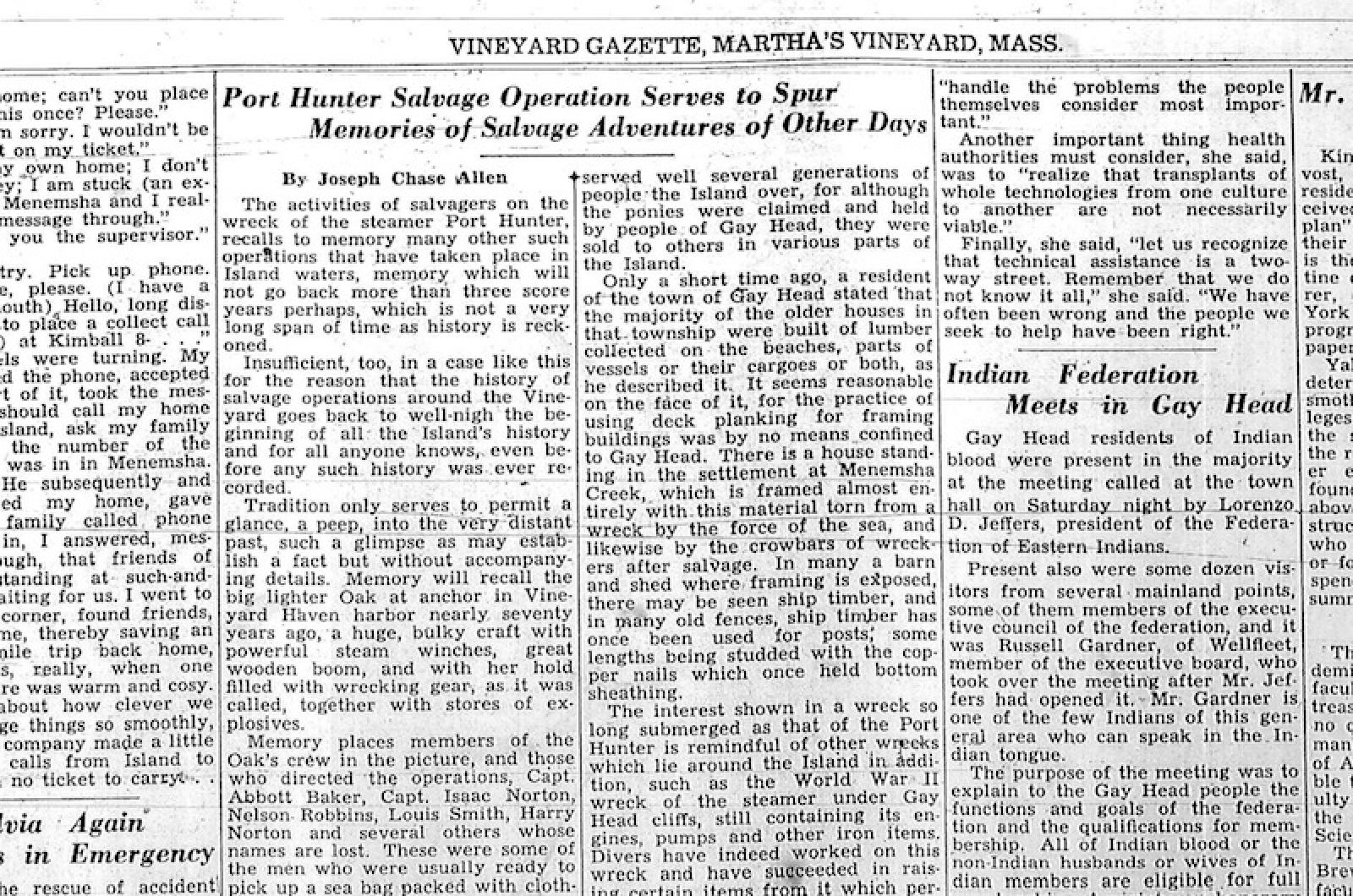From the October 21, 1969 edition of the Vineyard Gazette:
The history of salvage operations around the Vineyard goes back to well-nigh the beginning of the Island’s history and for all anyone knows, even before any such history was ever recorded.
Tradition only serves to permit a glance, a peep, into the very distant past. Memory will recall the big lighter Oak at anchor in Vineyard Haven harbor nearly seventy years ago, a huge, bulky craft with powerful steam winches, great wooden boom, and with her hold filled with wrecking gear, as it was called, together with stores of explosives.
Memory places members of the Oak’s crew in the picture, and those who directed the operations, Capt. Abbott Baker, Capt. Isaac Norton, Nelson Robbins, Louis Smith, Harry Norton and several others whose names are lost. These were some of the men who were usually ready to pick up a sea bag packed with clothing and go aboard a tug or the lighter when there was salvaging to be done or a vessel to be floated.
There were lengthy periods when a vessel ashore or in trouble was almost a daily occurrence among the swirling tides which surround the Vineyard and if the vessel was seriously damaged, there was salvaging to be done.
The beachcombing faction, which held to the principle that “finders are keepers,” met with virtually no interference as they went their ways. The deck-loads of lumber washed from foundering schooners and scattered for miles in the water and along the shores, comprised their ocean harvest. If the living quarters of officers and crew were destroyed and trunks or sea chests washed out, those things too were made prize by the beachcombers. But the bulk of the cargo remaining in the hull, either lumber, coal or other commodities, was salvaged by the authorized crafts and crews, employed by underwriters or agents.
Everyone has heard of the wreck of the steamer City of Columbus, a Savannah liner, of the loss of nearly two hundred lives and of the scramble which followed as her mixed cargo was washed out of the sunken wreck. Relics of this wreck are still to be found occasionally in Vineyard homes. They have heard also of the wreck of the ship Sylvia, also loaded with general cargo, food, spices, hardware, paint, liquor, clocks, pianos and tobacco, among a longer list.
Some will recall the schooner, loaded with coal, that crashed on the rocks of Cedar Tree Neck. This cargo was salvaged by authorized persons and was hauled by horses to Vineyard Haven. There were dozens of others where cargo was saved, and vessels either floated or stripped of all useful gear, including at times masts and spars.
Only a short time ago, a resident of the town of Gay Head stated that the majority of the older houses in that township were built of lumber collected on the beaches, parts of vessels or their cargoes or both, as he described it. It seems reasonable on the face of it, for the practice of using deck planking for framing buildings was by no means confined to Gay Head. There is a house standing in the settlement at Menemsha Creek, which is framed almost entirely with this material torn from a wreck by the force of the sea, and likewise by the crowbars of wreckers after salvage. In many a barn and shed where framing is exposed, there may be seen ship timber, and in many old fences, ship timber has once been used for posts.
The interest shown in a wreck so long submerged as that of the Port Hunter is remindful of other wrecks which lie around the Island, such as the World War II wreck of the steamer under Gay Head cliffs, still containing its engines, pumps and other iron items.
So far as is known, no one has attempted to explore the wreck of the steamer Kershaw, sunk in a collision off Oak Bluffs some thirty years ago. This Merchants and Miners cargo ship went to the bottom in twelve fathoms, and twelve men went with her.
The Kershaw carried a quantity of wool, partially spun and wound on large bobbins or reels. She carried shoes and office supplies in the form of ledgers and similar account books. Some of these items were lifted in a half-hearted, half-rigged attempt at salvage, but the effort was quickly abandoned. Thus the wreck still lies in the mud, or whatever may remain of it.
For wrecks have a fantastic way of disappearing around the Island. Some are moved by sea and tide, some settle deeply in mud. Some are ground to fragments on rocky ledges and some simply disappear and leave no trace. Few, if any, would be likely to attract salvagers today.
Yet the lure of such things must be recognized, even by those who have no kinship with the sea. To explore a sunken hulk, rusty or rotten, according to its construction, weed-grown and barnacled, half-floating, half-walking through the moving water, entering doorways or hatchways long submerged, it must provide an unusual thrill of expectancy. For there is always a chance, as it seems, that on such a quest, something may be found which will be cherished by the finder.
Compiled by Hilary Wall
library@mvgazette.com







Comments (2)
Comments
Comment policy »